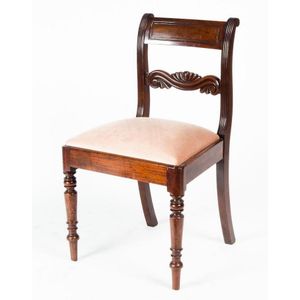Regency Mahogany Carver Chair with Velvet Seat
You must be a subscriber, and be logged in to view price and dealer details.
Subscribe Now to view actual auction price for this item
When you subscribe, you have the option of setting the currency in which to display prices to $Au, $US, $NZ or Stg.
- Regency Period - The Regency period in English furniture design refers to the period when King George III, was declared unfit to rule in 1811, and his son ruled as proxy as Prince Regent, until 1820, and then, after the death of his father as George IV until his death in 1830. The Regency period was preceded by the Georgian period (George I, George II, and George III: 1714 - 1811), and was followed by the William IV period, which only lasted until 1837 when William IV died as was succeeded by Queen Victoria.
- Circa - A Latin term meaning 'about', often used in the antique trade to give an approximate date for the piece, usually considered to be five years on either side of the circa year. Thus, circa 1900 means the piece was made about 1900, probably between 1895 and 1905. The expression is sometimes abbreviated to c.1900.
- Mahogany - Mahogany is a dense, close grained red-coloured timber from the West Indies and Central America. It was first imported into Europe in the the early 18th century and its use continued through the 19th century. It was popular for furniture making because of its strength, the wide boards available, the distinctive grain on some boards, termed flame mahogany and the rich warm colour of the timber when it was polished.. The "flame" was produced where a limb grew out from the trunk of the tree, and this timber was usually sliced into veneers for feature panels on doors, backs and cornices.
Some terms used to describe mahogany relate to the country from which it originally came, such as "Cuban" mahogany, "Honduras" mahogany etc. However unless the wood has been tested the names assigned are more a selling feature, rather than a true indication of the timber's origin.
This item has been included into following indexes:
- chairs, singles - Georgian 550
-
chairs, singles / pairs / threes, style or period
- carver or elbow chairs 252
- Regency 236
- chairs, singles / pairs / threes, timber - mahogany 1,120
Visually similar items

Dining Chair: English mahogany on ring turned legs with Thomas Hope scroll back, c1830s.

Cedar armchair, Australian c. 1826, the curved top rail above a plain curved cross rail, down swept arms on turned supports and raised on turned tapering legs, stamped on rear of back leg ALENEHAN. Height 87 cm

A spade back carver chair, Australian cedar, N.S.W. origin, circa 1860 51 cm across the arms

A set of eight Victorian mahogany balloon back chairs, second half 19th century, the chairs of waisted form having scrolling and acanthus carved mid rails to generous stuffover seats of shaped profile and supported on slender and tapering ribbed legs and t
